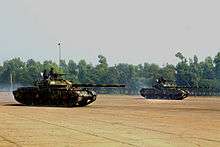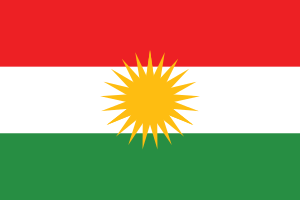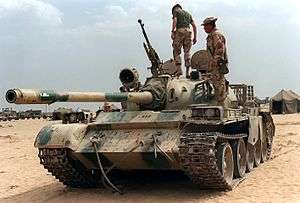Type 69/79 main battle tank
| Type 69-II | |
|---|---|
|
Iraqi Type 69-II captured during the Gulf War | |
| Type | Main battle tank |
| Place of origin | China |
| Service history | |
| In service | 1982 – present |
| Wars | Iran–Iraq War, Gulf War, Iraq War |
| Production history | |
| Designer | No. 60 Research Institute |
| Designed | 1963 – 1974 |
| Manufacturer | First Inner Mongolia Machinery Factory/Inner-Mongolia First Machine Group Company Limited |
| Specifications | |
| Weight | 36.7 tonnes[1] |
| Length | 6.24 m (Hull)[1] |
| Width | 3.3 m[1] |
| Height | 2.80 m |
| Crew | 4 |
|
| |
| Armor | 203 mm |
Main armament | 100/105 mm rifled tank gun |
Secondary armament | 7.62 mm coaxial and bow machine guns, 12.7 mm antiaircraft machine gun |
| Engine |
diesel 580 hp[1] (430 kW) |
| Power/weight | 15.8 hp/tonne[1] |
| Suspension | torsion-bar |
Operational range | 440 km[1] |
| Speed | 50 km/h[1] |
The Type 69 (Chinese: 69式; pinyin: Liùjiǔ shì) and Type 79 (Chinese: 79式; pinyin: Qījiǔ shì) are Chinese main battle tanks. Both developments of the Type 59 (based on the Soviet T-54A), they were the first main battle tanks developed independently by China.[2] Their lineage can be seen through the distinct gap between the first and second roadwheels. Other improvements included a new engine, ballistic computers, and laser rangefinders. The more advanced Type 79 was equipped with a 105 mm rifled gun,[1] also seen on the later Type 88 tank.
History
After the Sino-Soviet split, the Soviet Union withdrew its technical staff and support to China's arms industry. China's 617 Factory (Inner-Mongolia First Machine Group Co Ltd) was instructed to improve on the T-54A design (Type 59 MBT) in 1963, and created the Type 69. Improvements include a dual-axis stabilized 100 mm smoothbore gun, a new 580 hp engine, and an IR search light. However, the People's Liberation Army was not satisfied with the version, and it did not enter serial production. Some Western analysts incorrectly identified the Type 69 as a Chinese copy of the Soviet T-55, as opposed to the Type 59 being a copy of the T-54A.
During the 1969 Sino-Soviet border conflict, the PLA was able to capture a Soviet T-62 MBT. The captured tank was examined, and some of its components, such as the Soviet Luna IR searchlight system, were copied and integrated into the Type 69 design. The Type 69 and Type 79 tanks became the first independently Chinese-developed main battle tank.[2] However, the early version of the Type 69 were only used in limited quantities. The PLA was unsatisfied with the Type 69's performance, but ironically it became one of China's most successful armored vehicle exports. Over 2,000 were sold worldwide in the 1980s.
Relations between China and the West warmed in the 1980s, and China was able to import some Western technologies to improve its weapon systems. The Type 69 was upgraded with Western systems such as the British Marconi FCS, and the L7 105 mm gun. The new version received the designation Type 79, which represented the conclusion of China's first-generation tank development.
The simplicity, robustness and low cost of the tanks made them attractive on the export market, and China sold hundreds to both sides during the Iran–Iraq War. (Gelbart 1996:18) Many of the vehicles were later used by Saddam Hussein during the Gulf War and the 2003 Iraq War.
Myanmar Army Type 69 tanks also reportedly engaged Royal Thai Army M60A3 tanks in 2001 during the battle for Border Post 9631, although it is unclear if either side lost any vehicles.
Both the Type 69 and Type 79 tanks share almost identical hulls and turrets with the older Type 59. The only difference is that the two more recent tank models have been upgraded with better technologies that were either captured or bought from more advanced countries. (Gelbart 1996:17-19) The Chinese Type 59, 69 and 79 tanks can therefore be viewed as part of the same, evolutionary tank family in the same way that the Soviet T-54, -55 and -62 tanks share a common lineage. Only in the mid-1980s did the Chinese gain the expertise to begin experimenting with new indigenous tank designs that were not cast from the mold of the Type 59/69/79 family, and only in the 1990s did China begin producing truly modern tanks. (Gelbart 1996:20-24)
Today only a couple hundred Type 69/Type 79s remain in PLA inventory, mostly deployed with training or reserve units. The Type 69/Type 79 are being replaced by the newer Type 96 and Type 99 MBTs. The Type 69 is also known as WZ-121 by the manufacturer (NORINCO).
In Iraqi service

During the 1980s, China was reported to have sold hundreds of Type 59 and Type 69 MBTs to Iraq. By 1991 Gulf War, western analysts claim that Iraq had upgraded some Type 69s with a 105 mm gun, a 160 mm mortar, and a 125 mm gun with an auto-loader. All of them were reinforced with frontal layer armor welded on the glacis plate.[3] All these versions were known as Type 69-QMs. It was reported during the 1991 Gulf War that the Iraqi Type 69 units fought harder than the elite Republican Guard units, equipped with T-72 MBTs. One possible explanation is that Saddam ordered his Republican Guard units to preserve their strength, while sending the rest of the army, equipped with inferior Type 69 tanks, to frontline fight.
According to battle reports from the 2003 invasion of Iraq, Type 69-QMs were used by the Iraqi Army units defending Nasiriyah in March 2003, most of them being employed as artillery pillboxes.[4] They played an important role in the ambushes mounted against the US Army 507th Maintenance Company and Charlie Company of the 1st Battalion, 2nd Marines, before AH-1 Cobra helicopters wiped out the Iraqi tanks. Two Type 69s destroyed at least four vehicles of the 507th, among them a heavy truck rammed by one of the tanks.[5] There is also a first hand account of about four Type 69s hidden behind some buildings, pounding the Marines' Charlie Company with indirect fire and likely disabling several AAVs.[6] Some combat useless Type 59/69s were emplaced as decoys or mere obstacles.[7]
Variants
Prototypes
- Type 69 - Prototype based on the Type 59 hull, fitted with new 580 hp diesel engine, Type 69 100 mm smoothbore gun, IR searchlight, and laser rangefinder.
- Type 69-I - Prototype incorporating some technologies from captured Soviet T-62 MBT, such as the Luna IR searchlight system, and improved NBC protection.
Production variants

Type 69
- Type 69-IIA - First production version released in 1982, fitted with:
- Type 69-II 100 mm rifled gun
- New FCS system with:
- TSFC 2-axis gun stabilization
- Type 70 gunner sight
- TCRLA Laser rangefinder
- BCLA Ballistic computer
- Type 889 radio
- Rubber track skirts
- Storage racks on turret
- Smoke grenade launchers
- 2 diamond shaped oil cap on angled plate behind engine deck
This version was widely exported and produced under license in Pakistan by Heavy Industries Taxila (HIT). The Type 69-II is referred to as the Type 30 in the Royal Thai Army.[8]
- Type 69-IIB/C - Command version of the Type 69-II with additional communications equipment and auxiliary power pack. Features a long radio aerial and two storage boxes on the rear, containing cables and field phone.
- Type 653 ARV - Armored recovery vehicle based on the chassis of Type 69 MBT.[9] The Type 653 ARV is fielded with no turret but instead features a powered structure controlling a dozer blade at the front of the hull and a hydraulically powered crane. The crane is capable of lifting up to 70 tons.[10]
Type 79

- Type 69-III (Type 79) - Also designated WZ-121D, an improved Type 69-II incorporating Western technologies. In service with the PLA as the Type 79 MBT. In 1981, the first prototype was modified as per specification as Type 69-III. Two formal prototypes were built in 1983, equipped with key components such as a laser rangefinder. The Type 79 entered production in 1984, and was shown in public at the PRC's 35th anniversary parade in 1984. Improvements include:
- The first Chinese tank to incorporate rubber-padded tracks
- The first Chinese tank to close hatches automatically on detection of NBC agents
- Type 83 105 mm gun (improved L7 copy) with replaceable indigenous thermal sleeve (Type 79II)
- Passive IR sights or thermal imaging system
- British Marconi FCS with:
- TLRLA laser rangefinder
- BCLA ballistic computer
- TGSA gunner sight
- Type 79 liquid-cooled 730 hp diesel engine
- Type 79 fitted with Explosive Reactive Armor (ERA)
Foreign variants
Iraq
- Type 69-QM - Also known as T-55B inside the Iraqi Army. Type 69-II with standard 100 mm rifled main gun, armour reinforced with layer armour on the front glacis, an observation mast and, on some units, a 60 mm mortar. Command vehicles often fitted with blocks of appliqué spaced armour, similar to the so-called Enigma T-55s. Produced 1986–1988.
- Type 69-QM1 - Type 69-II upgraded with NATO standard 105 mm rifled gun and laser range-finder. Produced 1984–1988.
- Type 69-QM2 - Type 69-II upgraded with Warsaw Pact standard 125 mm (L80) smoothbore main gun and laser range-finder. Produced 1986–1991.
Bangladesh


Bangladesh Army Engineers improved its weaponry and armor system to make it more effective.
- Type 69-IIG - An upgraded Bangladeshi model with the following modifications:
- Bi-axis stabilised Type-83A (improved L-7 with bigger bore) 105mm smoothbore gun (NATO compatible), with semi-automatic loader, capable of firing ATGMs
- New fire control system (FCS), laser range-finder, thermal imaging sights & Combat data link
- 850 hp diesel engine
- Chinese 3rd generation explosive reactive armour (ERA) protection, automatic collective fire suppression system, LASER warning receiver, NBC suite.
- New communications and navigation equipment (including GPS receiver)
- Rubber padded track
Myanmar
- Myanmar army have Type-69 MBT 50 and Type-69-2 MBT 80. All were upgraded in 2007 May.
Non-military applications
A civilian variant of the Type 69/79 was used to develop the Chinese firefighting tank. Currently only three fire brigades in China have purchased such a vehicle.
Operators
Current operators

-
 Bangladesh: 235Type-69MkIIG tanks and 12 converted ARV
Bangladesh: 235Type-69MkIIG tanks and 12 converted ARV -
 Myanmar: 260 (Type 59D and Type-69 II)
Myanmar: 260 (Type 59D and Type-69 II) -
 People's Republic of China: 200+ Use by reserve and training units
People's Republic of China: 200+ Use by reserve and training units -
 Iran: 200
Iran: 200 -
 Iraq: Approximately 1,500 Type 59 and Type 69 tanks in 1990, later most were destroyed, but the remaining ones are still being used by Iraqi Army.
Iraq: Approximately 1,500 Type 59 and Type 69 tanks in 1990, later most were destroyed, but the remaining ones are still being used by Iraqi Army. -
 Iraqi Kurdistan: Peshmerga
Iraqi Kurdistan: Peshmerga -
 Pakistan: 400 Type 69-II tanks in service.[11]
Pakistan: 400 Type 69-II tanks in service.[11] -
 Sri Lanka: 20
Sri Lanka: 20 -
 Sudan: Manufactured under license in Sudan by MIC and PRC in Type-69 l 100, Type-79 100
Sudan: Manufactured under license in Sudan by MIC and PRC in Type-69 l 100, Type-79 100 -
 Zimbabwe: 10
Zimbabwe: 10
Former operators
-
 Thailand: 100
Thailand: 100
See also
References
- 1 2 3 4 5 6 7 8 Gelbart, Marsh (1996). Tanks main battle and light tanks. Brassey’s UK Ltd. pp. 18–19. ISBN 1-85753-168-X.
- 1 2 http://www.sinodefence.com/army/tank/type69.asp
- ↑ Modern Battle Tanks and Support Vehicles (PDF), UA: Al Port.
- ↑ "Deadliest battle of war so far", Sarasota Herald-Tribune, The New York Times News Service, March 24, 2003.
- ↑ (PDF), USA: SFTT http://www.sftt.us/PDF/article07102003a.pdf#prof Missing or empty
|title=(help). - ↑ Zeigler, Martin (2006). Three Block War II: Snipers in the Sky. iUniverse, pp. 34, 36. ISBN 0-595-38816-7
- ↑ Scales, Robert H. and Murray, Williamson (2003). The Iraq war: a military history. Harvard University Press, p. 120. ISBN 0-674-01280-1
- ↑ Jane's Armour and Artillery 1997-98 ISBN 0-7106-1542-6
- ↑ F Foss, Christopher (22 November 2000). "Al Khalid MBT to enter production". Retrieved 15 April 2013.
- ↑ "Chinese Type 653 ARV". Retrieved 2013-04-15.
- ↑ "Pakistan Army".
- "Type 69 Main Battle Tank". FAS Military Analysis Network. Retrieved 1 June 2005.
- "Bangladesh Type 69/79 Tank Development & Upgrade Program". Bangladesh Military Forces. Retrieved 9 May 2008.
- Type 69Mk. II G
External links
| Wikimedia Commons has media related to Type 69 tanks. |
- Bangladesh Military Forces
- Sino Defense Today
- Global security.org
- FAS
- Onwar.com
- Type 79 tank photos and specs, Chinese

